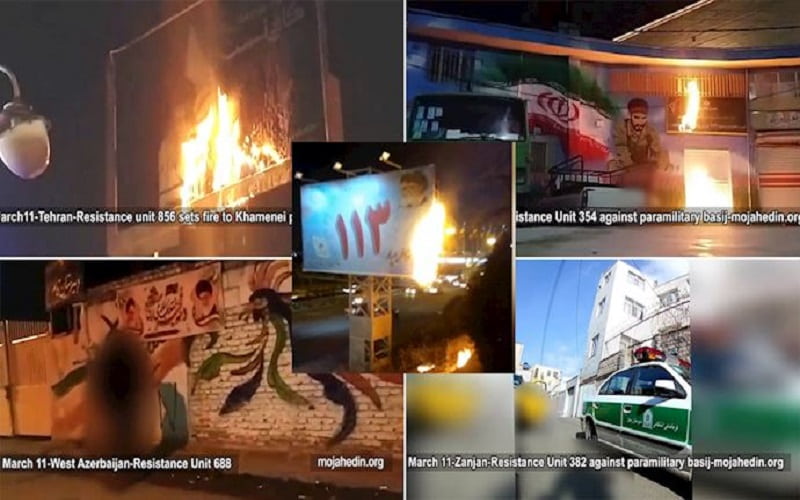Resistance Units in Iran conduct 100 anti-regime activities in the past three weeks
Resistance units in Iran have conducted over 100 anti-regime activities in various cities across the country in the past three weeks (since February 20, 2019) despite severe repressive measures by the Iranian regime.
The resistance units in Iran carried out protest actions in Tehran, Salmas, Uroumieh, Babolsar, Esfahan, Karaj, Chahbahar, Andimeshk, Makou, Khorramabad, Semnan, Abadan, Hendijan, Khoi, Zanjan, Amol, Golpayegan, Sabzevar, Neyshabour, , Azarshahr, Qazvin, Kazeroun, Dorood, Miyandoab, and other locations.
Resistance units in Iran torched or tore down regime banners depicting Khomeini and Khamenei and other regime symbols at major regime centers or public thoroughfares. The units also wrote graffiti and hung banners calling for Death to Khamenei, Rouhani, and supporting Iranian resistance leader Rajavi. They also hung banners depicting the Iranian Resistance’s president-elect for future Iran, Mrs. Maryam Rajavi, from bridges, buildings, and other locations.
Secretariat of the National Council of Resistance of Iran
March 15, 2019
More about resistance units in Iran
As the resistance units are integrated in the society it’s a hard task for the enemy to identify them, thus, while maintaining their security, they can significantly strike at the enemy and actively participate in organizing social protests.
What is the history of resistance units?
A ‘resistance unit’ is a term that was first introduced by Che Guevara during the Latin American revolutions. They were units that fought against the dictators of these countries. The term entered the world’s literature then after and in Iran these units were referred to as ‘resistance cells’ during 1980s.
The resistance units have stemmed from a strategy which aims at the overthrow of a dictatorial regime.
When a group of elites rule the country and recognize no rights for the people, this is a dictatorial regime and the people have the right to revolt and overthrow it.
s stated in the introduction to the Universal Declaration of Human Rights:
“Whereas it is essential, if man is not to be compelled to have recourse, as a last resort, to rebellion against tyranny and oppression, that human rights should be protected by the rule of law.”
In the 1980s, Iran’s resistance units were referred to as ” resistance cells”, but since the beginning of September 2013, following the Iranian regime’s attack on Camp Ashraf which resulted in the death of 52 of MEK members, Massoud Rajavi, Iran’s Resistance leader, announced the roadmap for creating 1,000 Ashrafs (resistance units) inside Iran. Following the protests in early 2018 these units began their activities widely throughout Iran.
Are the resistance units separated entities from the society?
Resistance units have stemmed from the people and continue to survive by their support.
They courageously organize the uprising and have a leading role in the battle against the corrupt and criminal forces of the enemy.
The resistance units’ members honestly pursue the goals of the resistance’s leadership and promote them.
They deeply believe that the overthrow of the clerical regime can be achieved by their dedication to this cause and by showing courage in confronting the mullahs’ mercenaries.
